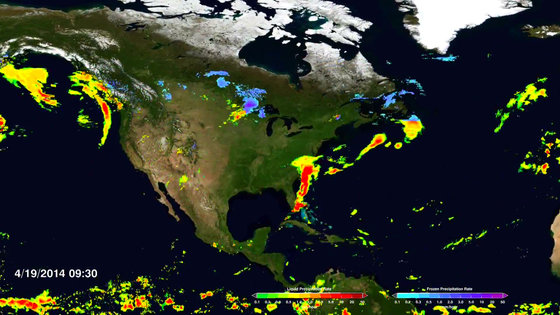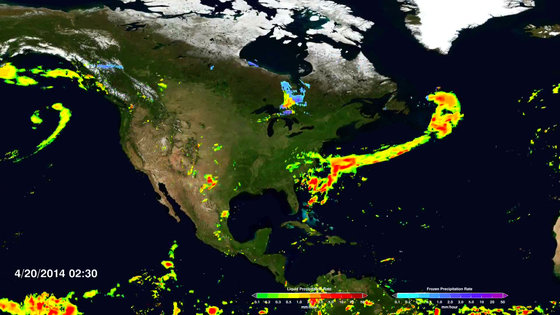A movie that understands at a glance how rain and snow are going on the earth

The mission that NASA is conducting jointly with JAXA and other international organizations is "Global precipitation observation plan(GPM) ", this mission uses 12 satellite networks to observe atmospheric precipitation observations. Based on this observation data, data on rain and snow around the world can be seen every 30 minutes Movie "NASA | First Global Rainfall and Snowfall Map from New Mission"Published by NASA.
NASA | First Global Rainfall and Snowfall Map from New Mission - YouTube
GPM observes precipitation every 30 minutes of the whole world.

With GPM, multi satellite for precipitation observation, high resolution data of 10 kilometers square can be taken.

It is rain that is represented by yellow green, yellow, orange, red gradation, and color represents precipitation. For example, if the color is yellowish green, the precipitation is 0.1 to 0.5 mm per hour, yellow if it is yellow, 1.0 to 3.0 mm for oranges, 3.0 to 50 mm for red.

Clouds are supposed not to be displayed, but if you follow a mass of rain, you can see how it moves.

A gob of rain that sprinkled with gulli and swirled in the Atlantic Ocean.

Time has changed and precipitation data on June 9, 2014 appears. Because it is June, the northern hemisphere is summer and the southern hemisphere is winter.

When looking at a little up, the blue color in the red frame part at the bottom of the screen predicts and displays it using the algorithm, "Here it is snowing" based on the information observed from outer space Things. In other words, the place where snow may be falling is represented in blue.

In the vicinity of the Antarctic Ocean, rain is moving while swirling from the west to the east. This is because there are small islands scattered in the Antarctic Ocean, where the wind hits and turns into a tornado.

In the tropics near the equator, the rain is moving from the east to the west. This is so-calledTropical convective activityIt seems to be said.


Looking at the state of the rain falling on the earth, you can see that rain is increasing or decreasing precipitation while moving a considerably long distance. In Japan, rain often flows from the Eurasian continent, and it seems that rain often flows from Europe and the Middle East via China or rain north east from Southeast Asia.

Related Posts:
in Video, Posted by logu_ii







